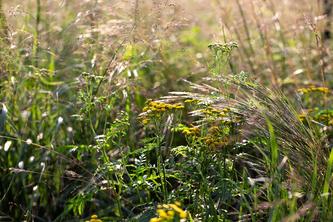
For decades, the mountain pine beetle (MPB) has caused an unprecedented amount of forest mortality in western North America, tearing through pine stands from the Pacific Coast all the way to the Black Hills of South Dakota. These black, pearlescent bark beetles destroy pine stands by mass attacking trees, carving extensive galleries beneath the bark. They also spread diseases through forests by carrying fungi and other pathogens with them from tree to tree.
And one day soon, the pest could very well knock on Minnesota’s door.
A warming climate, unprecedented beetle numbers, and firewood and timber transport could help this forest pest make its way to Minnesota. That’s why, even though researchers have yet to find the mountain pine beetle in the state, the Minnesota Invasive Terrestrial Plants and Pests Center (MITPPC) has ranked it as the top invasive insect priority for research funding.
MITPPC funds researchers at the University of Minnesota as they work to prevent the beetle from arriving and prepare for what would happen if it does. These scientists, led by Brian Aukema, a professor in the Department of Entomology in the College of Food, Agricultural and Natural Resource Sciences, have been studying how the mountain pine beetle might fare in Minnesota.
The search for natural enemies
Once in Minnesota, the mountain pine beetle would encounter a different competitive landscape. For one, the MPB would have to adapt to pine tree species it has never faced before. Additionally, the insect would overlap with local species of native bark beetles, such as the eastern five-spined ips bark beetle.
“Our goal is to help determine whether Minnesota’s native natural enemies that [compete with] native bark beetles would [also] recognize and respond to mountain pine beetle pheromones,” says Aukema. Anticipating how the beetle would fare in this new context can help hone bio-control measures and other management strategies that Minnesota can get started on before the insect arrives.
The MPB would have to contend with competition from other native wood-boring insects, too, such as long-horned beetles. Long-horned beetles feed aggressively underneath tree bark and could, in theory, inadvertently destroy MPB broods while munching away. Aukema had hoped these and other insects might make it more difficult for MPB to gain a foothold in Minnesota by responding to the same pheromones released by MPB when colonizing a tree.
Unfortunately, Aukema says, “We found that insects in the Great Lakes region may not optimally recognize mountain pine beetle aggregation pheromones if the insect were to arrive.”
Measuring the MPB's tenacity for travel
Research has long shown that humans transport invasive bark beetles by transporting firewood and timber. But U of M researchers investigated how far the beetles can travel on their own. During the summer of 2021, the team tested pine forests around Missoula, MT, and into the grassland range to the east, as well as the northwestern Black Hills of South Dakota, using a trap line that radiated from eastern Wyoming to the eastern border of Badlands National Park.
In previous research, MITPPC scientists noticed that the mountain pine beetle could travel up to 33 miles from an infested forest. This time, they did not see such a wide range for the insect, but MPB densities can fluctuate considerably from year to year.
Infested forests in South Dakota, which are roughly 500 miles away from the nearest mature pine forests in Minnesota, host the nearest populations. Given this history of findings, Aukema says, “We expect that the risk of mountain pine beetle reaching Minnesota by blowing in from the Black Hills is extremely low.”
Future directions
“This new research continues to reaffirm the threat MPB poses to the pines of Minnesota,” says Rob Venette, director of MITPPC. “We’ve invested in it because we believe it helps inform quarantine regulations, which are critical to keep this insect out of our beloved state. … This research has an immediate application to helping keep Minnesota's forests safe.”
Says Aukema: “It’s not every day that a funding agency has the capacity to fund proactive research rather than reacting to realized threats, as we so often need to do with invasive species.”





